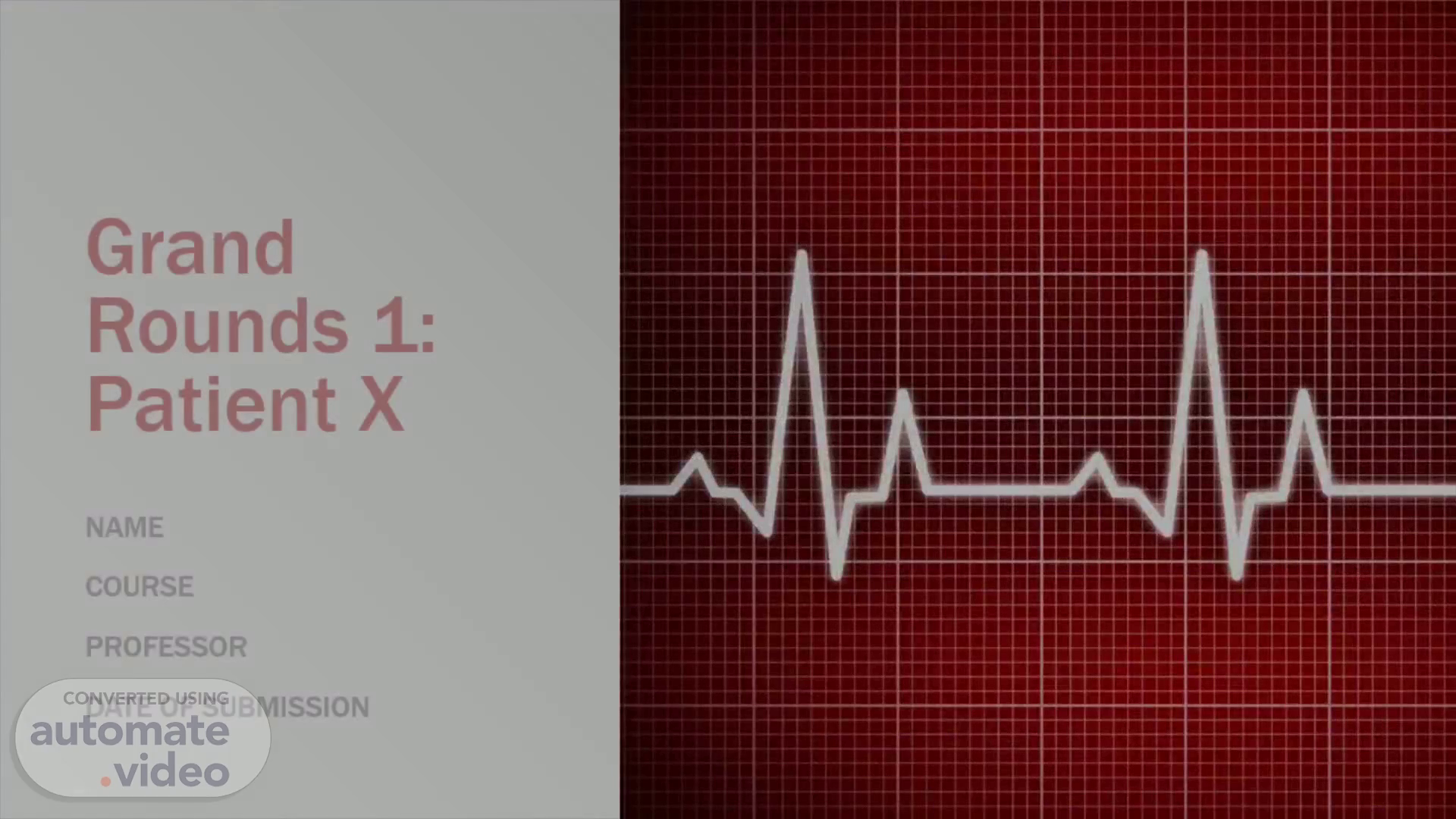
Grand Rounds 1: Patient X
Scene 1 (0s)
Grand Rounds 1: Patient X. NAME COURSE PROFESSOR DATE OF SUBMISSION.
Scene 2 (8s)
[Audio] Patient X is a 90-year-old female who was brought in by her daughter with a chief complaint of swelling and discomfort in her left lower abdomen. She denies any fever, chills, or abdominal pain. She had previously been admitted and treated for sepsis, receiving IV antibiotics followed by a course of oral antibiotics..
Scene 3 (31s)
[Audio] Patient X has a lengthy medical history, including obstructive uropathy, recurrent UTIs, asthma, and stage IV cervical cancer. ER examination results were normal, with creatinine levels at 1.3 and no leucocytosis. Urinalysis revealed WBCs of over 100/npf, RBCs of 21-50 hPR, and large leukocyte esterase. BUN levels increased from 17 to 40 mg/Dl. Symptoms included dysuria, severe pyuria, a left lower extremity DVT, and a burning sensation during urination. Consequently, ceftriaxone and heparin have been prescribed, an infusion has been ordered, and admission is requested..
Scene 4 (1m 24s)
[Audio] Considering several clues is crucial when endeavouring to arrive at a diagnosis. Dysuria, hematuria, frequent urination, chills, fever, suprapubic pain, costovertebral angle tenderness, or flank pain can all act as pointers to a particular condition and should thus be taken into account when diagnosing..
Scene 5 (1m 47s)
[Audio] Suspected complicated UTI is associated with instrumentation and is estimated to have upto 69% of prevention if proper initial placement is made. Improper treatment of UTI can result in repeated occurrence and difficulties in treatment with antibiotics, potentially leading to abscess and sepsis in other organs. It is therefore essential that healthcare professionals are educated on prevention and patients be aware of the importance of adhering to their treatment..
Scene 6 (2m 18s)
[Audio] Patient X's weakened immune system due to radiotherapy and chemotherapy treatments, combined with her advanced age, could be the cause of her condition. According to Sabih and Leslie (2023), this demographic is more prone to developing UTIs. It is also possible that the recurrent UTI is caused by multi-drug resistant bacterial strains, and her UTI complications might have been brought on by the instrumentation procedure she underwent, with a daily risk of 10% for bacteremia and 25% of those bacteremia cases developing into UTIs..
Scene 7 (2m 57s)
[Audio] It is essential that proper management is delivered to achieve these goals, such as alleviating pain and discomfort with both pharmacological and non-pharmacological remedies. Patient must also be able to achieve normal urinary elimination and demonstrate knowledge of UTIs, including its causes, risk factors, and treatment. Additionally, patient must adhere to prescribed medication and pharmacological interventions, as well as empty the bladder completely and regularly..
Scene 8 (3m 29s)
[Audio] Patient X needs to take steps to address their complicated urinary tract infection. This includes relieving pain and promoting normal urinary function, educating the patient on their condition and treatment options, administering medications as necessary, monitoring for any complications, and checking diagnostic results. Through the right interventions, Patient X can effectively manage their UTI..
Scene 9 (3m 57s)
[Audio] As healthcare professionals, it is essential to consider the risks that come with improper prescribing and consider a comprehensive approach to the treatment and management of complicated UTIs. And now, let us look at how our next speaker, Tim, achieved success at a young age..
Scene 10 (4m 16s)
[Audio] Monitoring on a regular basis can be beneficial in making well-informed decisions. These decisions are crucial for evaluating successful treatment responses and effectively managing difficult urinary tract infections. Regular monitoring is also advantageous for enhancing patient treatment results..
Scene 11 (4m 37s)
[Audio] Understanding how preexisting medical conditions of patient X interplay with providing effective care is paramount. In the case of "obstructive uropathy", the filtration process of the kidneys is compromised, thus allowing bacteria to enter the bloodstream. Additionally, "cervical cancer" weakens the patient's immune system, making it more difficult to fight off infection. To ensure the most effective care for patient X, it is necessary to comprehend the implications that preexisting conditions may have, and to deliver comprehensive and appropriate patient care. This requires complex decision-making and a detailed assessment of the patient's medical history..
Scene 12 (5m 22s)
[Audio] I investigated the role of frequent versus less frequent instrumentation of ureteral stents in the development of complicated UTIs in UTI patients. Specifically, I studied how the two methods affect the prevalence of complicated UTIs in UTI patients and what possible relevant factors may influence the result..
Scene 13 (5m 44s)
[Audio] This research article is a comprehensive guide on the etiology, pathophysiology, and treatment of complicated urinary tract infections. It has an evidence-based approach to diagnosing and treating this condition, and also offers an insight into the prognosis and complications associated with complicated UTIs. Overall, the article provides invaluable information for healthcare providers for treating patients with complicated UTIs..
Scene 14 (6m 15s)
[Audio] Patient X is an example of a Complicated Urinary Tract Infection. For further information on this illness, we have referred to the text by Sabih and Leslie which is an authoritative source and provides crucial information about this medical condition. Anyone researching this issue should consult this text and cite it in their own work..
Scene 15 (6m 37s)
[Audio] I appreciate you taking the time to come and listen to this presentation. I hope you found it useful for your informative purposes. I wish you all the best in your upcoming endeavours. Thank you again for your time..